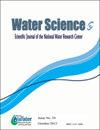Delineation and mapping of palaeochannels using remote sensing, geophysical, and sedimentological techniques: A comprehensive approach
Q2 Environmental Science
引用次数: 7
Abstract
ABSTRACT Palaeochannels are remnants of rivers or stream channels that flowed in the past and have been currently filled or buried by younger fluviatile sediments. There are a number of techniques for detecting palaeochannels with each of them having its own intrinsic advantages and disadvantages. In the present study, apart from applying different approaches, the capabilities, and effectiveness of the approaches to locate and map palaeochannels are compared. Remote sensing-based approaches are comprised of high-resolution satellite datasets and a LiDAR-derived elevation map for displaying extensive drainage networks of surface feature channels hypothesized to be palaeochannels, palaeorivers, or palaeovalleys. Ground-penetrating radar (GPR) transects along with concurrent visual observations are ground-truthing field approaches and has proved to be one of the most appropriate and accurate methods for locating palaeochannels due to their capability to identify subsurface sedimentary stratigraphy innate to palaeochannels. Nevertheless, visual field observations for ground-truthing of prospective palaeochnnels either exhibiting only subtle alterations in desiccation or vegetation are considered a potent field approach. The present review work lays a strong emphasis on delineation and mapping of palaeochannels using remote sensing, geophysical, and sedimentological techniques to meet the sustainable groundwater development goals.利用遥感、地球物理和沉积学技术的古河道圈定和制图:综合方法
古河道是过去流动的河流或溪流河道的残余物,目前已被较年轻的流质沉积物填满或掩埋。探测古水道的技术有很多,每种技术都有其固有的优点和缺点。本研究除了采用不同的方法外,还比较了各种方法在古河道定位和制图中的能力和有效性。基于遥感的方法包括高分辨率卫星数据集和激光雷达衍生的高程图,用于显示假设为古河道、古河流或古山谷的地表特征通道的广泛排水网络。探地雷达(GPR)样带和同步目视观测是一种地面真实场方法,由于其能够识别古河道固有的地下沉积地层,已被证明是定位古河道最合适和最准确的方法之一。尽管如此,对可能的古通道进行实地实地观测,要么只显示出干燥或植被的细微变化,被认为是一种有效的实地方法。为了实现地下水可持续发展的目标,本文着重强调利用遥感、地球物理和沉积学技术对古河道进行圈定和制图。
本文章由计算机程序翻译,如有差异,请以英文原文为准。
求助全文
约1分钟内获得全文
求助全文

 求助内容:
求助内容: 应助结果提醒方式:
应助结果提醒方式:


